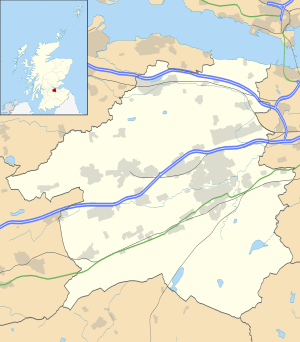Abercorn
| Abercorn | |
| Scottish Gaelic: Obar Chùirnidh | |
| Abercorn Church |
|
 Abercorn |
|
| OS grid reference | NT082788 |
|---|---|
| Civil parish | Abercorn |
| Council area | West Lothian |
| Lieutenancy area | West Lothian |
| Country | Scotland |
| Sovereign state | United Kingdom |
| Post town | SOUTH QUEENSFERRY |
| Postcode district | EH30 |
| Dialling code | 0131 |
| Police | Scottish |
| Fire | Scottish |
| Ambulance | Scottish |
| EU Parliament | Scotland |
| UK Parliament | Linlithgow and East Falkirk |
| Scottish Parliament | Linlithgow |
Coordinates: 55°59′35″N 3°28′23″W / 55.993°N 3.473°W
Abercorn (Gaelic: Obar Chùirnidh, Old English: Æburcurnig) is a village and parish in West Lothian, Scotland. Close to the south coast of the Firth of Forth, the village is around 5 km (3.1 mi) west of South Queensferry.
History
Etymologically, Abercorn is a Cumbric place-name meaning 'mouth of the river Cornie'. The name of the river itself is also Cumbric and seems to derive from *kernan 'mound, hill' and so to be named after the hill on which Abercorn stands.[1]
The English monk and historian Bede mentions Abercorn as the site of a monastery and seat of Bishop Trumwine who was the only bishop of the Northumbrian see of the Picts. The monastery is now known to have existed close to the present day church. The church itself dates partially from the 12th century, although its most interesting features are the private aisles created for the three major families of the area, the Dalyells, the Hamiltons, and later the Hopes, who had their own enclosure behind the altar built by architect William Bruce. The Hope mausoleum, designed by William Burn, is located in the kirkyard. Older burial monuments include Norsemen "hogback" stones, and fragments of 7th century Northumbrian crosses.[2]
A castle also existed here from Norman times, although it was demolished in 1455 by James II during a siege against the "Black Douglases" and their chief James Douglas, 9th Earl of Douglas. The House of the Binns, seat of the Dalyell family, is within the parish.[2]
The lands of Abercorn were granted to Claud Hamilton in the 16th century. His son was later created the Earl of Abercorn. In the early 17th century, a branch of the Hamilton dynasty moved to Ulster in Ireland. The family would, henceforth, play a major part in Ulster affairs. Thus, the estate was later sold to the Hope family, who were created Earls of Hopetoun, and built Hopetoun House to the east of the village.[2]
Abercorn's population was recorded as 1,044 at the time of the 1821 census, although it has since declined.[3]
Ecclesiastical History
Bishopric
For a very short time, Abercorn was a residential bishopric. In 681, during the reign of King Ecgfrith of Northumbria, Theodore of Tarsus, Archbishop of Canterbury, appointed Trumwine "Bishop of the Picts", with his seat at Abercorn.[4] This was part of a more general division of the Northumbrian church by Theodore, who also created the Bishopric of Hexham by separation from the Bishopric of Lindisfarne.[5]
Four years later, Trumwine may have been present at the defeat and death of Ecgfrith at the Battle of Dun Nechtain,[6] after which he was forced to flee from his Pictish bishopric, retiring to the monastery at Whitby.[7] The bishopric of Abercorn thus ceased to be a residential diocese.
Titular see
It is today listed by the Catholic Church as a titular see.[8] The diocese was nominally restored as a Latin Catholic titular bishopric in 1973. It must not be confounded with the former Roman Catholic Diocese of Abercorn (Northern Rhodesia) in southern Africa.
It has had the following (so far near-consecutive, Anglosaxon) incumbents, all of the lowest (episcopal) rank :
- Richard Charles Patrick Hanifen (1974.07.06 – 1983.11.10)
- John Aloysius Mone (1984.04.24 – 1988.03.08)
- John Charles Dunne (1988.10.21 – ...), Auxiliary Bishop emeritus of Rockville Centre (USA)
See also
- Duke of Abercorn
- Trumwine of Abercorn
- Newtownstewart, County Tyrone
- Abercorn Northern Rhodesia now Mbala Zambia. See also www.Abercornucopia.com for more on this extraordinary little hill station in the heart of Africa.
References
- ↑ Bethany Fox, 'The P-Celtic Place-Names of North-East England and South-East Scotland', The Heroic Age, 10 (2007), http://www.heroicage.org/issues/10/fox.html (appendix at http://www.heroicage.org/issues/10/fox-appendix.html).
- 1 2 3 Abercorn History from The Seton Family retrieved 24 May 2013
- ↑ Abercorn from Vision of Britain retrieved 24 May 2013
- ↑ Bede, Ecclesiastical History IV.12.
- ↑ Bertam Colgrave (tr.), Bede: The Ecclesiastical History of the English People, p. 403, s.v. 192.
- ↑ Fraser, Battle of Dunnichen, p. 47.
- ↑ Bede, Ecclesiastical History IV.26.
- ↑ Annuario Pontificio 2013 (Libreria Editrice Vaticana 2013 ISBN 978-88-209-9070-1), p. 821
Sources and External links
| Wikimedia Commons has media related to Abercorn. |
- grid reference NT082788
- Gazetteer of Scotland
- Ancient Lothian
- GigaCatholic with titular incumbent biography links